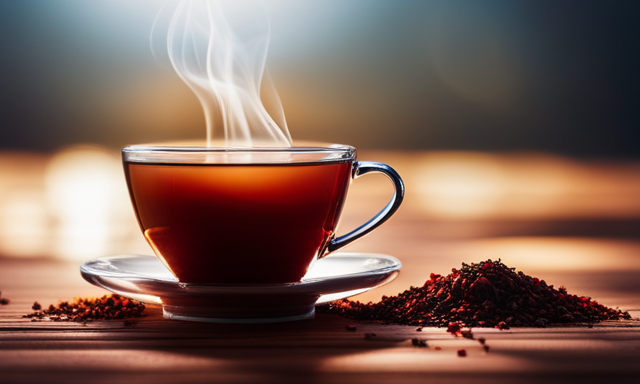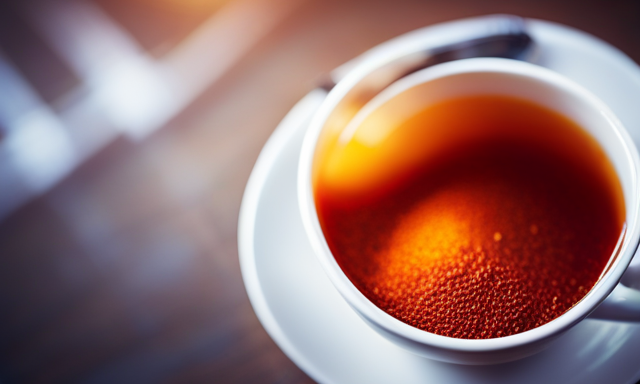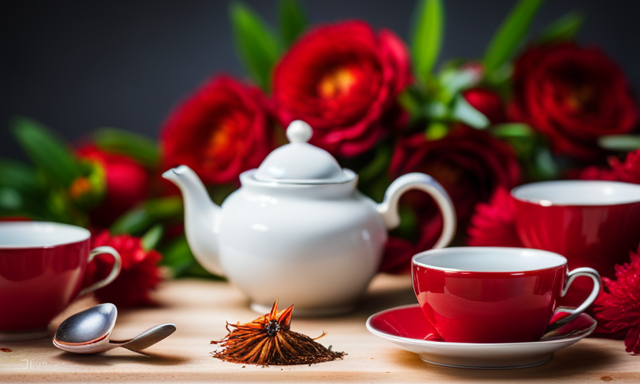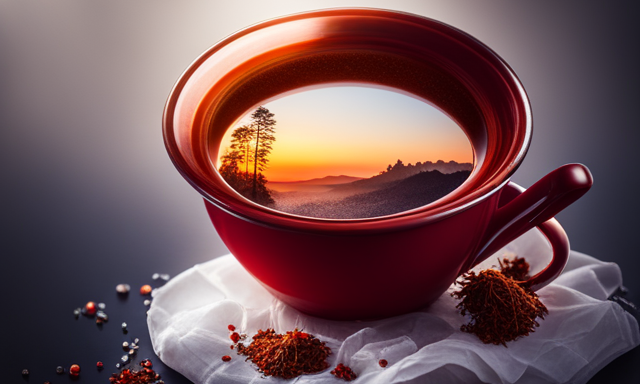Have you ever wondered what rooibos tea tastes like?
Well, let me tell you, it’s a delightful experience for the palate. As a tea enthusiast, I’ve had the pleasure of exploring the world of beverages, and rooibos tea has quickly become one of my favorites.
This unique tea originates from South Africa and is cultivated using sustainable methods, which adds to its appeal. When you take a sip, you’ll notice its natural and earthy flavor notes, reminiscent of the African soil. But what sets rooibos tea apart is its subtle sweetness and delicate floral undertones, making it a truly refreshing and aromatic beverage.
The best part? Unlike some teas, rooibos has no bitterness or astringency, allowing you to fully enjoy its smooth and soothing taste. Whether you prefer to brew it hot or cold, this versatile tea is sure to satisfy your cravings.
And don’t forget about the numerous health benefits and nutritional value it offers. So, if you’re curious about the taste of rooibos tea, join me as we dive deeper into this fascinating drink.
Key Takeaways
- Rooibos tea has a unique taste with earthy and slightly sweet notes.
- It is a versatile beverage that can be enjoyed hot or cold and pairs well with a variety of foods.
- Rooibos tea is rich in antioxidants, caffeine-free, and has several health benefits, including improving skin health and supporting heart health.
- Brewing and enjoying rooibos tea is popular among tea enthusiasts and it is a great alternative to traditional caffeinated teas.
A Brief Introduction to Rooibos Tea
If you’re looking to explore the world of tea, rooibos tea is a fantastic choice due to its unique flavor profile. Rooibos tea, also known as red bush tea, is a herbal tea made from the leaves of the Aspalathus linearis plant, which is native to South Africa.
One of the benefits of rooibos tea is that it’s naturally caffeine-free, making it a great alternative for those who want to limit their caffeine intake. Another benefit is its high antioxidant content, which can help boost the immune system and promote overall health.
To make rooibos tea, simply steep the leaves in boiling water for 5-7 minutes, or until desired strength is reached. The resulting brew has a naturally sweet and nutty flavor, with hints of vanilla and caramel. It is often enjoyed on its own, but can also be enhanced with a splash of milk or a drizzle of honey.
Now, let’s delve into the origin and cultivation of rooibos tea.
Origin and Cultivation of Rooibos Tea
When you try this unique South African herbal infusion, you’ll be surprised to learn that it grows exclusively in the Cederberg region, making it a rare and sought-after beverage. The origin history of Rooibos tea dates back centuries, with the indigenous Khoisan people being the first to discover its remarkable properties. Today, Rooibos farming methods have evolved, but the traditional practices are still respected to maintain the tea’s authenticity. The cultivation process involves carefully nurturing the Aspalathus linearis plant, which thrives in the region’s sandy soil and Mediterranean climate. Rooibos plants are harvested by hand, ensuring the delicate leaves are carefully preserved. To provide you with a visual representation of the tea’s origin and cultivation, here’s a table:
| Origin History | Rooibos Farming Methods |
|---|---|
| Discovered by the Khoisan people | Hand-harvested for preservation |
| Centuries-old tradition | Thrives in sandy soil and Mediterranean climate |
| Exclusive to the Cederberg region | Carefully nurtured Aspalathus linearis plant |
With its rich history and unique cultivation methods, Rooibos tea offers a natural and earthy flavor profile that we’ll explore in the next section.
Natural and Earthy Flavor Notes
Indulging in a sip of this exquisite South African infusion will transport your taste buds to a realm of natural and earthy flavor notes that captivate the senses. Rooibos tea boasts an earthy flavor profile that is unmatched by any other herbal infusion options. Here are four reasons why this tea is a delightful choice for those seeking a unique and refreshing beverage experience:
-
Woody undertones: Rooibos tea offers a distinct woody taste, reminiscent of the plant’s origin in the rugged Cederberg region of South Africa.
-
Nutty nuances: The infusion carries subtle nutty undertones that add depth and complexity to each sip.
-
Smoky essence: A hint of smokiness adds an intriguing element to the overall flavor, creating a truly memorable drinking experience.
-
Rich and robust: Despite its herbal nature, rooibos tea has a bold and full-bodied flavor that satisfies even the most discerning palates.
As we delve further, we’ll explore the delightful interplay of subtle sweetness and floral undertones that make rooibos tea a truly exceptional choice for tea enthusiasts.
Subtle Sweetness and Floral Undertones
Immerse yourself in the world of rooibos and discover the delightful interplay of subtle sweetness and floral undertones that will transport your senses to a blissful oasis of flavor. Rooibos tea, also known as red bush tea, is renowned for its naturally sweet taste. The sweetness is not overpowering, but rather a gentle caress on the palate that leaves a lingering satisfaction. This unique flavor profile is complemented by the presence of floral notes, which add a touch of elegance and sophistication to each sip. Imagine savoring a warm cup of rooibos tea, where the sweetness dances harmoniously with the delicate floral undertones, creating a symphony of taste that is both comforting and refreshing. As you explore the world of rooibos, you will be delighted to discover that this tea has no bitterness or astringency, making it a perfect choice for those who prefer a smooth and mellow brew.
No Bitterness or Astringency
Experience the pure pleasure of a cup of rooibos, as its smooth and mellow essence caresses your palate, leaving behind no hint of bitterness or astringency.
Rooibos tea has a unique flavor profile that sets it apart from other teas. Its taste is often described as naturally sweet with subtle floral undertones. The absence of bitterness and astringency makes it incredibly enjoyable to drink, even without the need for sweeteners or additives.
To fully appreciate the flavor of rooibos tea, it’s important to brew it correctly. Bring fresh water to a boil and steep the tea leaves for about 5-7 minutes. This will allow the rich flavors to infuse into the water, resulting in a delicious and satisfying cup of tea.
Now, let’s move on to comparing rooibos tea with black and green tea.
Comparison to Black and Green Tea
After discussing the absence of bitterness or astringency in rooibos tea, let’s now delve into how it compares to black and green tea.
As a tea enthusiast, I’ve had the pleasure of savoring all three varieties, and I must say that rooibos tea offers a unique taste experience. Unlike black tea, which can be bold and robust, and green tea, which can have a grassy or vegetal flavor, rooibos tea has a naturally sweet and nutty taste. It’s also caffeine-free, making it a great alternative for those looking to reduce their caffeine intake.
In addition to its delightful taste, rooibos tea is known for its numerous health benefits, such as its high antioxidant content and potential anti-inflammatory properties. With its distinct flavor profile and health advantages, rooibos tea truly stands out among its tea counterparts.
Now, let’s explore the versatility in brewing methods.
Versatility in Brewing Methods
When it comes to brewing methods, there are various ways to prepare and enjoy the versatile flavors of rooibos. Different brewing techniques can bring out different nuances in the taste of the tea.
For a stronger and bolder flavor, you can opt for a longer steeping time, typically around 5-7 minutes. This allows the leaves to fully infuse and release their rich flavors. If you prefer a lighter and more delicate taste, a shorter steeping time of 3-4 minutes would be ideal.
Additionally, the brewing temperature also plays a role in the final taste. For a more robust flavor, use boiling water, while a lower temperature of around 176-194°F (80-90°C) will result in a milder flavor.
Now that we’ve explored the versatility in brewing methods, let’s move on to discuss the health benefits and nutritional value of rooibos tea.
Health Benefits and Nutritional Value
Discover the numerous health benefits and rich nutritional value that can be found within a cup of this versatile beverage. Rooibos tea isn’t just a delicious and refreshing drink, but it also offers a range of health benefits.
Here are four reasons why incorporating rooibos tea into your daily routine can be beneficial to your well-being:
-
High antioxidant content: Rooibos tea is packed with antioxidants, such as aspalathin and nothofagin, which help fight against free radicals in the body and reduce the risk of chronic diseases.
-
Boosts the immune system: The tea is rich in minerals, including calcium, magnesium, and zinc, which are essential for a strong immune system.
-
Supports digestion: Rooibos tea is known for its anti-inflammatory properties, which can help soothe digestive issues like stomach cramps and indigestion.
-
Calming and relaxing: This tea contains a natural compound called quercetin, which has been shown to have a calming effect on the nervous system, helping to reduce stress and promote relaxation.
Now, let’s explore how rooibos tea can be paired with food and desserts to enhance your culinary experience.
Pairing Suggestions with Food and Desserts
To enhance your culinary experience, consider pairing rooibos tea with a variety of delicious foods and desserts. Rooibos tea has a distinct flavor that can complement a wide range of dishes.
For a light and refreshing option, try pairing it with salads, grilled vegetables, or seafood. The earthy and slightly sweet notes of rooibos tea can also be a great match for roasted meats, such as chicken or lamb.
When it comes to desserts, rooibos tea pairs well with chocolate-based treats like brownies or chocolate mousse. You can also pair it with fruity desserts like berry tarts or peach cobbler to bring out the tea’s natural sweetness.
So go ahead and explore the world of rooibos tea pairings, and discover the perfect combination to satisfy your taste buds.
Now, let’s move on to exploring different varieties and blends.
Exploring Different Varieties and Blends
Get ready to embark on a journey of flavors as we delve into the world of different varieties and blends of rooibos tea. When it’s time to explore flavors, rooibos tea offers a delightful range of unique blends that are sure to satisfy any tea lover’s palate. Here are three exceptional varieties to try:
-
Vanilla Rooibos: Indulge in the smooth and creamy taste of vanilla infused with the earthy sweetness of rooibos. This blend offers a comforting and aromatic experience.
-
Berry Rooibos: Experience the burst of fruity goodness with a blend of rooibos and various berries. The natural sweetness of the berries complements the mild and nutty flavor of rooibos perfectly.
-
Spiced Rooibos: Warm up with the invigorating blend of rooibos and spices like cinnamon, ginger, and cloves. This combination creates a rich and flavorful tea that’s perfect for chilly evenings.
Exploring these unique blends will surely elevate your rooibos tea experience to a whole new level.
Frequently Asked Questions
How long does rooibos tea need to steep for optimal flavor?
For optimal flavor, steep rooibos tea for 5-7 minutes. This brings out its unique flavor profile, which is often described as earthy, nutty, and slightly sweet. The longer steeping time allows the flavors to fully develop.
Is rooibos tea naturally caffeine-free?
Rooibos tea is naturally caffeine-free, making it a great option for those looking to avoid caffeine. In addition, it offers numerous health benefits such as antioxidants and anti-inflammatory properties.
Can rooibos tea be enjoyed both hot and cold?
Yes, rooibos tea can be enjoyed both hot and cold. It is a versatile beverage that can be infused with other flavors. Additionally, it offers numerous health benefits, such as being rich in antioxidants and promoting digestion.
Are there any potential side effects or risks associated with drinking rooibos tea?
There are no known potential side effects or risks associated with drinking rooibos tea. In fact, it is believed to have potential health benefits. However, it is always recommended to consume it in moderation and not exceed the recommended daily intake.
What is the recommended storage method to ensure the freshness of rooibos tea?
To ensure the freshness of rooibos tea, I recommend storing it in an airtight container in a cool, dark place. This helps preserve its delicate flavors and aromas, ensuring a delightful and invigorating tea experience every time.
Conclusion
In conclusion, after exploring the world of rooibos tea, I can confidently say that it’s a delightful and versatile beverage. Its natural and earthy flavor, combined with subtle sweetness and floral undertones, creates a truly unique taste experience.
What sets it apart is the absence of bitterness or astringency, making it a perfect choice for those who prefer a milder brew. Whether enjoyed hot or cold, rooibos tea offers a host of health benefits and can be paired beautifully with a variety of foods and desserts.
As the old adage goes, "A cup of rooibos tea a day keeps the doctor away."










